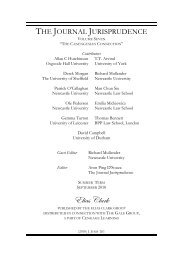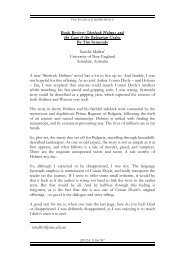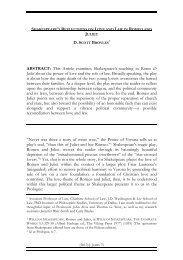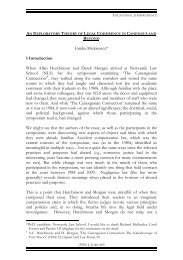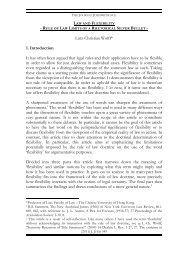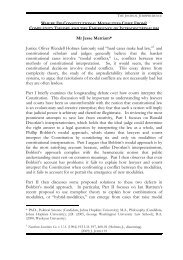Editorial - The Journal Jurisprudence
Editorial - The Journal Jurisprudence
Editorial - The Journal Jurisprudence
You also want an ePaper? Increase the reach of your titles
YUMPU automatically turns print PDFs into web optimized ePapers that Google loves.
THE JOURNAL JURISPRUDENCE<br />
EDITORIAL: LAW AND ECONOMICS<br />
<strong>The</strong> <strong>Journal</strong> <strong>Jurisprudence</strong>, as an idea, was born nearly two years ago, when I felt<br />
that jurisprudence, as a discipline, was dying a slow death. With our first issue,<br />
last September, I came to know that jurisprudence does have a following, and<br />
quite a loyal one at that. With time and effort, the celebrity of our journal has<br />
grown, with that an affirmation of the life and strength of our discipline.<br />
After the success of our first edition, we have gained new publication and<br />
distribution avenues. I am pleased to welcome the many subscribers who have<br />
committed to ensuring the journal’s long term viability. Furthermore, William<br />
S. Hein & Co. Inc. will be carrying <strong>Jurisprudence</strong> in their electronic database,<br />
HeinOnline.<br />
<strong>The</strong> major news, I am pleased to report, is the decision of our publishers, the<br />
Elias Clark Group, to increasing the number of issues per year from two to<br />
four. Instead of a bi-annual edition, <strong>Jurisprudence</strong> will now be published four<br />
times per year. In a nod to the anglophiles among us, these four issues will<br />
coincide with the four terms of the legal year – Hillary (February), Easter<br />
(May), Trinity (August) and Michaelmas (November).<br />
This move is a vote of confidence in the <strong>Journal</strong> and a reflection of the vast<br />
amount of submission we have received. Every day, I wake up to an inbox<br />
filled with wonderful new jurisprudential insights, interest from the far ends of<br />
the world and the comradery of legal philosophers of many persuasions. In<br />
one day this February, we received eight submissions and we have generally<br />
averaged one or two per day, which is extraordinary for a journal which<br />
originally aimed to publish only six articles per year.<br />
This is an overwhelming expression of faith in legal philosophy and I deeply<br />
enjoy reading each submission. With our expanded number of annual editions,<br />
we will be able to accommodate even more opinions, insights and original<br />
research.<br />
In this edition, we are pleased to publish four dynamic articles on the topic of<br />
“<strong>Jurisprudence</strong> and Economics.” In setting the theme many months ago, I<br />
worried that it was too specific. In fact, it may be too broad – the richness and<br />
depth of economist working in law and legal philosophers dabbling in<br />
economics is genuinely unbelievable.<br />
Mr Benjamin Taibleson of Yale University, a young scholar of obviously great<br />
potential, writes on the topic of Archaic Criminal Codes and Penitential Indulgences.<br />
One does not think of theology giving insight into jurisprudence and<br />
(2009) J. JURIS 9
economics, but we must remember that the roots of civil law are in canon law,<br />
at least in western, particularly English, jurisdictions. Mr Taibleson is an able<br />
and original scholar, and <strong>The</strong> <strong>Journal</strong> <strong>Jurisprudence</strong> is pleased to publish his work.<br />
Dr.Jur. Eric Engle of Harvard University, who published in the inaugural<br />
edition of <strong>Jurisprudence</strong>, delivers a commanding critique of the Law and<br />
Economics school in his article Law and Economics: <strong>The</strong>oretical Puffery, Exaggerated<br />
Claims and Counterfactual Models. Dr Engle is a scholar of command stature and<br />
one is inclined to remember Law as Lex vs Ius (2008 J. Juris 31) and realise that<br />
he is diligently critiquing modern legal methods. Engle’s challenge to typical<br />
jurisprudential rationales is the foundation of his development of original and<br />
substantial theory.<br />
In contrast to the challenge posed by Dr Engle, Professor Nicholas Mercuro<br />
of Michigan State University’s James Madison College gives an authoritative<br />
history of the Law and Economics (L&E) movement. He walks us through the<br />
history and evolution of L&E and foregrounds the void created by legal<br />
realism. It is a pleasure to publish <strong>The</strong> Jurisprudential Niche Occupied by Law and<br />
Economics, a paper of diligent scholarship that, I am certain, will be of<br />
importance to scholars for years to come.<br />
Finally, Dr Martin Gramatikov of Tilburg University forges a new path in the<br />
study of jurisprudence and economics. He uses the one-two punch of<br />
intelligible language and excellent research to illustrate the impediments to<br />
justice experienced by so many. I am certain that his insights will be of great<br />
importance, not only to legal scholars, but also to courts and to practitioners.<br />
Lawyers, through little fault of their own, often forget that many obstacles lie<br />
in the path to justice for many people, particularly the poor. Dr Gramatikov’s<br />
article proposes a framework for measuring these costs and foregrounds issues<br />
that are easily forgotten in the world of six-minute billing increments. <strong>The</strong><br />
<strong>Journal</strong> <strong>Jurisprudence</strong> is honoured to publish such a meaningful and important<br />
work as A Framework for Measuring the Costs of Paths to Justice.<br />
Mr Aron Ping D’Souza<br />
Melbourne, Australia<br />
12 February 2009<br />
(2009) J. JURIS 10



